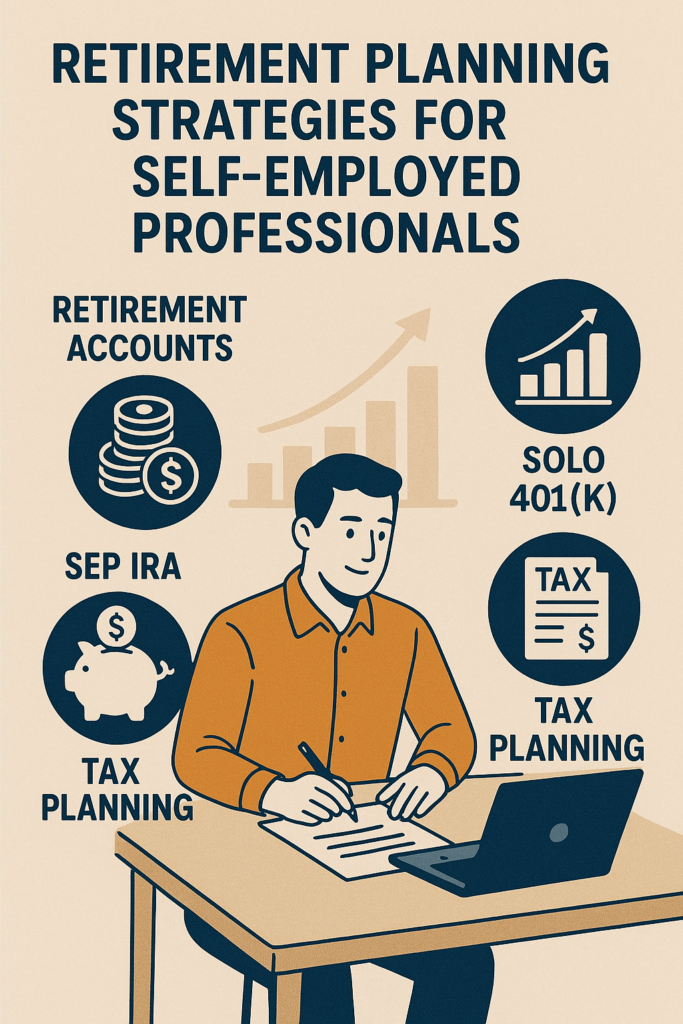When you’re self-employed, retirement planning isn’t automatic—it’s a proactive, intentional process. Without access to employer-sponsored plans like 401(k)s or pensions, you’re solely responsible for securing your financial future. But the good news? You have more flexibility and control.
In this article, we’ll break down the most effective retirement planning strategies for the self-employed, so you can build wealth, reduce your tax burden, and enjoy long-term financial freedom.
Why Retirement Planning is Different for the Self-Employed
Traditional employees have structured options for retirement. As a freelancer, entrepreneur, or independent contractor, you must build your own retirement ecosystem. This includes:
- Choosing the right retirement accounts
- Managing inconsistent income
- Balancing tax planning with investment growth
- Developing long-term savings discipline
Strategic financial planning for the self-employed is essential—not just for retirement, but for financial independence at every life stage.
🔗 Learn more about how we help solopreneurs succeed
1. Understand Your Retirement Plan Options
As a self-employed professional, you have several powerful tools available to build retirement wealth:
Solo 401(k)
Ideal for sole proprietors or business owners with no employees, the Solo 401(k) offers:
- High contribution limits
- Pre-tax or Roth options
- Optional spousal participation
You can contribute both as employer and employee—up to $66,000 (2023 limit) depending on income.
SEP IRA (Simplified Employee Pension)
Perfect for freelancers and small business owners. Key benefits:
- Easy to set up and maintain
- Contributions are tax-deductible
- Allows up to 25% of compensation (max $66,000 in 2023)
SIMPLE IRA
Best for small businesses with fewer than 100 employees. It’s:
- Cost-effective and easy to manage
- Requires employer matching contributions
- Lower contribution limits than Solo 401(k) or SEP IRA
📘 Explore retirement services tailored for the self-employed
2. Set Monthly Retirement Contributions
Treat your retirement contributions like a fixed expense. Even if your income varies, consistency matters. Consider:
- Setting up automatic transfers into your retirement account
- Starting with 10–15% of your monthly income
- Increasing contributions during high-income months
The earlier you begin, the more compound interest works in your favor.
3. Diversify Your Investments for Growth
It’s not enough to save—you must invest wisely. Spread your portfolio across:
- Low-cost index funds or ETFs
- Bonds for stability
- Real estate or REITs
- Roth options for tax-free withdrawals in retirement
Review and rebalance annually to ensure your risk tolerance aligns with your goals.
Need expert advice? 👉 Book a planning session today
4. Plan for Taxes in Retirement
Self-employed individuals should plan both now and later for taxes. Consider:
- Contributing to Roth accounts for tax-free withdrawals
- Using pre-tax contributions to reduce current tax liability
- Factoring in Social Security and Medicare taxes in later years
A balanced tax strategy is critical to maximizing retirement income.
📌 Connect with a licensed Enrolled Agent
5. Build an Emergency Fund and Safety Net
Before maxing out retirement savings, protect your present. Self-employed workers should:
- Maintain 6–12 months of living expenses in a high-yield savings account
- Purchase disability and health insurance
- Build business reserves to avoid dipping into retirement funds
This foundation supports longevity in your career and your savings plan.
6. Set Retirement Goals and Review Annually
Success begins with clear vision. Ask yourself:
- At what age do I want to retire?
- How much will I need monthly in retirement?
- How much will healthcare and lifestyle cost me?
Review these goals at least once a year and adjust based on income, lifestyle, and inflation trends.
Stay ahead of the curve with our expert updates and real-time tips
Final Thoughts
Retirement planning for the self-employed is a long game—but one that rewards discipline, smart investing, and tax-savvy decisions. With the right strategy, you can retire comfortably on your terms.
Ready to start planning your future today?
📈 Contact us for personalized financial support
And if we’ve helped you take the next step, don’t forget to leave a review ⭐
Frequently Asked Questions
1. What’s the best retirement plan for self-employed individuals?
The Solo 401(k) is often the most flexible and has the highest contribution limits, but it depends on your income and business structure.
2. How much should I save for retirement each year?
Aim to save at least 15% of your annual income, increasing it during high-earning years.
3. Can I have both a Roth IRA and a Solo 401(k)?
Yes! Combining both gives you a diversified tax strategy with pre- and post-tax benefits.
4. What happens if I start retirement planning late?
It’s never too late. Maximize contributions, reduce expenses, and consider delaying retirement to boost savings.




 por
por